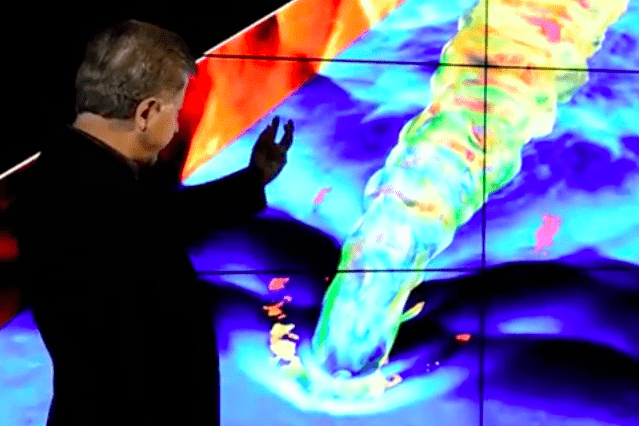Researchers at Stanford University are working on solutions to the inherent difficulties of hypersonic flight — speeds of over Mach 5, or 3,000 mph (4828 km/h) — and they’ve created one amazing computer model illustrating the dynamics of air temperature variations created at those intense speeds.
[/caption]
According to a news article from Stanford University, “Real-world laboratories can only go so far in reproducing such conditions, and test vehicles are rendered extraordinarily vulnerable. Of the U.S. government’s three most recent tests, two ended in vehicle failure.”
The video above shows some of the research team’s animation model — one of if not the largest engineering calculation ever created, it ran on 163,000 processors simultaneously and took 4 days to complete! And it’s utterly mesmerizing… not to mention invaluable to researchers.
“It’s something you could never have created unless you put computer scientists, mathematicians, mechanical engineers and aerospace engineers together in the same room,” said Juan Alonso, associate professor of aeronautics and astronautics at Stanford. “Do it, though, and you can produce some really magical results.”
In a (very tiny) nutshell, the behavior of air through an hypersonic engine — called a scramjet (for supersonic combustion ramjet) — changes at extremely high speeds. In order for aircraft to travel and maneuver reliably the scramjets have to be engineered to account for the way the air will respond.
“If you put too much fuel in the engine when you try to start it, you get a phenomenon called ‘thermal choking,’ where shock waves propagate back through the engine,” explained Parviz Moin, the Franklin P. and Caroline M. Johnson Professor in the School of Engineering. “Essentially, the engine doesn’t get enough oxygen and it dies. It’s like trying to light a match in a hurricane.”
“Understanding and being able to predict this phenomena has been one of the big challenges. It’s not one number or two numbers that come out of it at the end of the day… it is all of these structures that you see back there, the richness of it. It is understanding that allows you to control.”
– Parvis Moin, Stanford University professor
Thanks to this study, made possible by a 5-year $20 million grant from the U.S. Department of Energy, we may one day have aircraft that can travel up to 15 times the speed of sound. But the team’s groundbreaking computations aren’t just reserved for aeronautic aspirations.
“These same technologies can be used to quantify flow of air around wind farms, for example, or for complex global climate models,” said Alonso.
Read more on the Stanford University News here.
Video by Steve Fyffe and Linda Cicero. Source: Stanford University.


my buddy’s mother go t paid $21508 the previous week. she is making money on the internet and bought a $386500 house. All she did was get fortunate and put into work the instructions explained on this web site===>> ?????? http://hiringfreelancers.blogspot.com
I have been very skeptical to suggestions of scramjet use, because they are not useful for airplanes over land (currently forbidden) or for large launchers (too little mass to orbit). However, this suggestion for a cheap nanosat launcher gave me reason to pause:
“Piece by piece, parts of the puzzle that may conceivably drive down costs to as low as $300,000 per launch, are falling into place, according to hypersonic researchers at Boeing. Building on these pieces, the company has unveiled a small launch vehicle (SLV) concept aimed at the smallsat market, and it could be in service as early as 2020.”
It would be launched from a WK2 carrier, employ two different resuable airbreathing stages and a rocket third stage which would open up the envelope for scramjet gradual improvements from mach 10 onwards.
Possibly this is a market segment where scramjet technology could mature:
“Boeing’s study evaluated several propulsion options for the first stage, which is designed to reach a staging Mach number of 4.5 before releasing the second stage. Options include the Atrex air-turbo ramjet with expander cycle, an experimental precooled engine under development by the Japan Aerospace Exploration Agency that works as both a turbojet and ramjet.”
“The second stage is a 37-ft.-long, hypersonic waverider design with “an inward-turning inlet that feeds a circular combustor scramjet,” says Bowcutt. The second stage takes over at Mach 4.5 and accelerates to Mach 10 for the final staging of the rocket-powered third stage.”
my friend’s aunt brought home $17621 last month. she gets paid on the internet and bought a $566900 condo. All she did was get blessed and work up the guide revealed on this web site===>> ?????? http://hiringfreelancers.blogspot.com